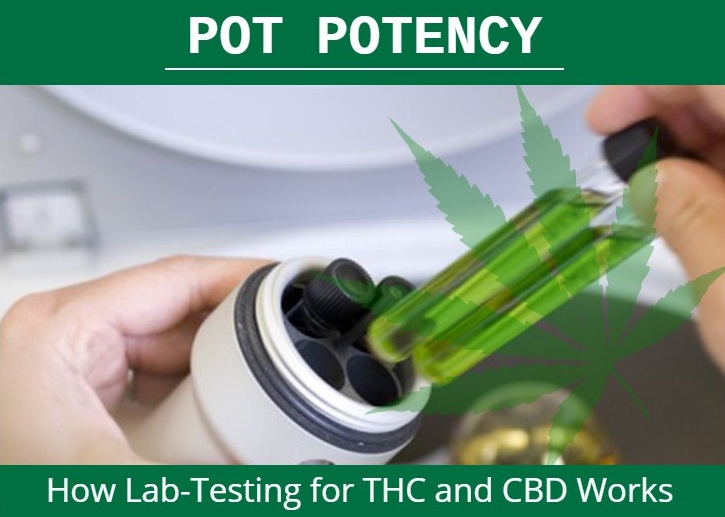
Because companies send their cannabis products to a laboratory for testing, consumers have unique data, such as potency and composition, which enables them to make informed decisions before buying. For medical patients especially, who require specific therapeutic properties, accurate testing is of paramount importance. It is also crucial for recreational users, as products vary and influence effects.
Laboratories use an array of testing methods to determine the potency, quality, and safety of marijuana products, and it gives this data to consumers. Although states have their own specific requirements for testing, some procedures are standard within the industry. In particular, potency analysis is a major drive for pot testing, as it provides consumers with accurate information about CBD and THC levels.
Testing Weed for CBD and THC Concentrations
The levels of specific cannabinoids present in marijuana plants quantify their potency. Since cannabidiol, or CBD, and tetrahydrocannabinol, or THC, are the two primary cannabinoids, the law mandates that manufacturers obtain potency information about them. Because these two cannabinoids greatly influence the effects of weed products, it is paramount for consumers to know their concentrations.
For example, while most recreational users will want a product with higher THC levels than CBD, the majority of medical patients need strains that are higher in CBD. Other molecules, such as flavonoids, terpenes, and minor cannabinoids, are also up for testing, although the law does not require it. As such, the primary focus is and always will be on potency testing for CBD and THC levels.
How Laboratories Measure Levels of CBD and THC
Laboratories are able to measure THC and CBD concentrations in a variety of different ways. However, High Performance Liquid Chromatography, or HPLC, is without doubt the most common technique employed. It allows laboratories to separate and quantify numerous chemicals in a simple liquid solution. It is both easy to do and provides accurate results.
When using the HPLC technique, testing centers collect samples form cannabis flowers and mix them with solvents, most notably ethanol. They then pump that solution through a tube at high pressure. Inside the tube is a material that, based on their specific chemical properties, attracts some of the molecules required for testing. There is a detector located at the end of the tube.
Those molecules attracted to the material in the tube will take longer to detect, since they will naturally travel slower than others will. Additionally, HPLC detectors measure the absorbance of ultraviolet light, which has a direct association with certain compounds. When these compounds eventually reach the detector, it measures their relative abundance.
Since different cannabinoids, such as CBD and THC, do not travel through the tube at the same speed, the detector will measure them at different times. This allows for detailed characterization of each sample. These measurements are what you see when you look at the CBD and THC values on the back of marijuana packaging. Since these values are crucial to consumer choice, their accuracy is imperative.
Because of the volatile nature of terpenes, detecting and measuring them requires a different chromatography method entirely. Since terpenes are highly volatile, they are mostly gaseous and evaporate very easily. Cannabinoids, in contrast, will remain stable when in a liquid solution. Because of the gaseousness of volatile terpenes, however, laboratories use a different method to test for them.
Standardization of Marijuana Testing
According to a laboratory certified by Washington State, Confidence Analytics, “there are no strong regulations in place about how cannabis chemicals are measured. However, HPLC has emerged as the dominant technique for measuring cannabinoids.” This differs greatly from other industries, all of which have specific requirements for laboratory equipment and specific guidelines for testing techniques.
Because regulations are lacking concerning cannabis testing, it can cause major discrepancies in data for both potency and cannabinoids. Currently, lawmakers in most legal states are pushing for standardization of all marijuana testing to ensure consistency in potency values across testing centers. This is important, as discrepancies can greatly affect the consumer and patient experience.
In Washington State, for example, several I-502 accredited testing centers are playing a vital game of “round robin.” They are taking cannabis samples from unknown strains, measuring their potency, and then comparing the results among themselves. If each laboratory uses the correct testing practices, then the resulting potency information should be very similar among them.
To ensure quality and safety of pot products, it is imperative that states consider a variety of testing methods for standardization. Distinct testing techniques are necessary for the collection of information on terpenes, levels of residual solvents, and contamination, for example. In order to guarantee consumer safety and ensure transparency in the industry, testing must be consistent and accurate.
Recently, much controversy has surfaced regarding testing methods for potency. In some cases, manufacturers stand accused of deliberately inflating the results of THC levels. It has proven challenging implementing any sort of standard for testing procedures, since there are significant variations in requirements between states. For this reason, the industry needs a national standard for pot analysis.
